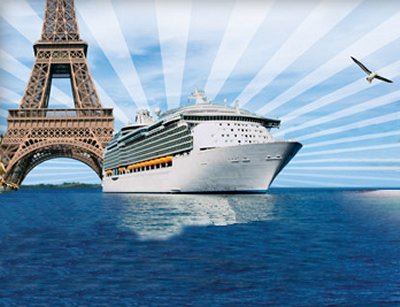 |
Oslo 2010
|
Thursday, May 06 - Oslo, Norway
Friday, May 07- day at sea
Saturday, May 08 - Normandy (Paris), France
Sunday, May 09 - Cherbourg, France
Monday, May 10 - Dublin, Ireland
Tuesday, May 11 - day at sea
Wednesday, May 12 - Edinburgh, Scotland
Thursday, May 13 - Loch Ness, Scotland
Friday, May 14 - day at sea
Saturday, May 15 - Oslo, Norway
|
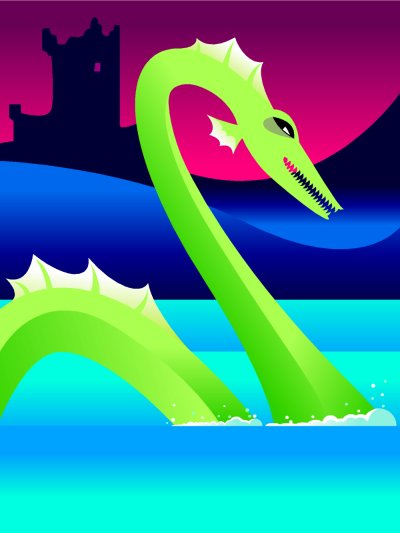 |
|
The SSQQ 2010
Oslo Cruise
Thursday, May 6th -
Saturday, May 15th
A 9-day cruise across the North Sea
from Norway to the Normandy
Coast
from Normandy to Ireland
from Ireland to Scotland
and back to Norway
aboard
Royal Caribbean's Vision of the Seas
|
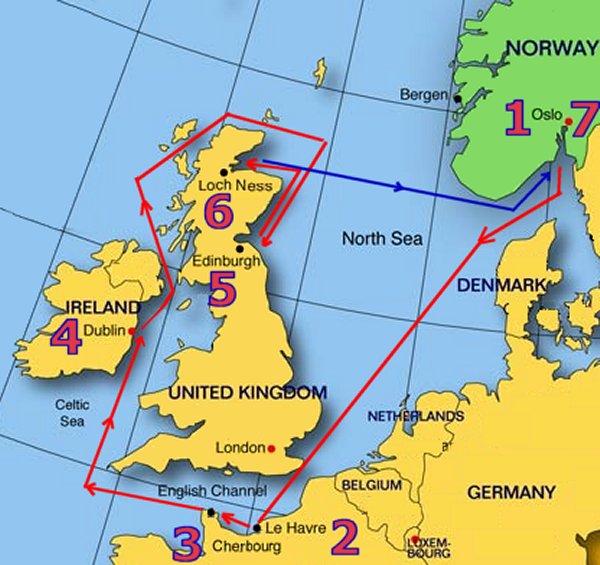 |
|
We start with the Fjords of Oslo,
then sail to see Paris - the spectacular Eiffel
Tower, the Louvre, Notre Dame Cathedral, the Arc de Triomphe, and
the fabled Moulin Rouge.
After Paris, we
move down the coast to Cherbourg and the beaches of Normandy
where D-Day took place in 1944.
Then it is on to Dublin
and the stunning green vistas of Ireland.
We wrap up our
trip in Scotland with
the Castles of Edinburgh one day and a visit to the mysterious Loch Ness
Monster the next!
Day One:
Oslo, Norway --
Departs 5:00 pm
Day Two: Fun
Day at Sea Cruising the North Sea
Day Three:
Paris, France (Le Havre) -- 9 am - Midnight
Day Four:
Cherbourg, France -- 7
am - 3 pm
Day Five:
Dublin, Ireland -- 11 am- 11 pm
Day Six:
Fun Day at Sea Cruising the British Isles
Day Seven:
Edinburgh, Scotland -- 8 am -
5 pm
Day Eight:
Loch Ness, Scotland -- 9:00 am -- 6 pm
Day Nine: Fun Day at Sea Cruising the North Sea
Day ten: Oslo, Norway -- Arrive 7:00 am
|
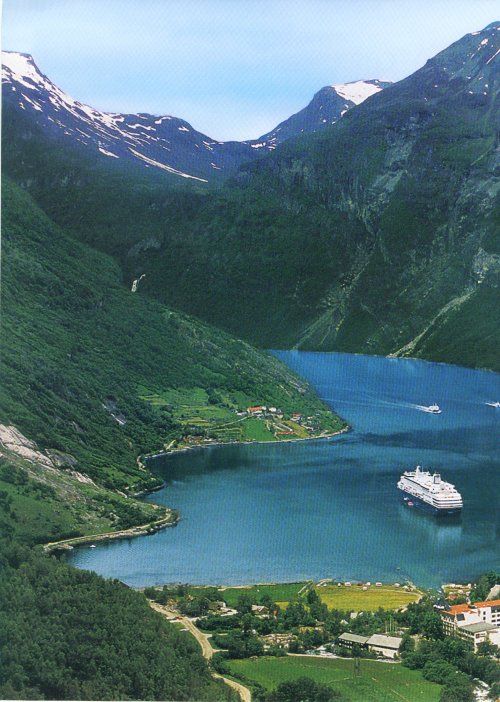 |
|
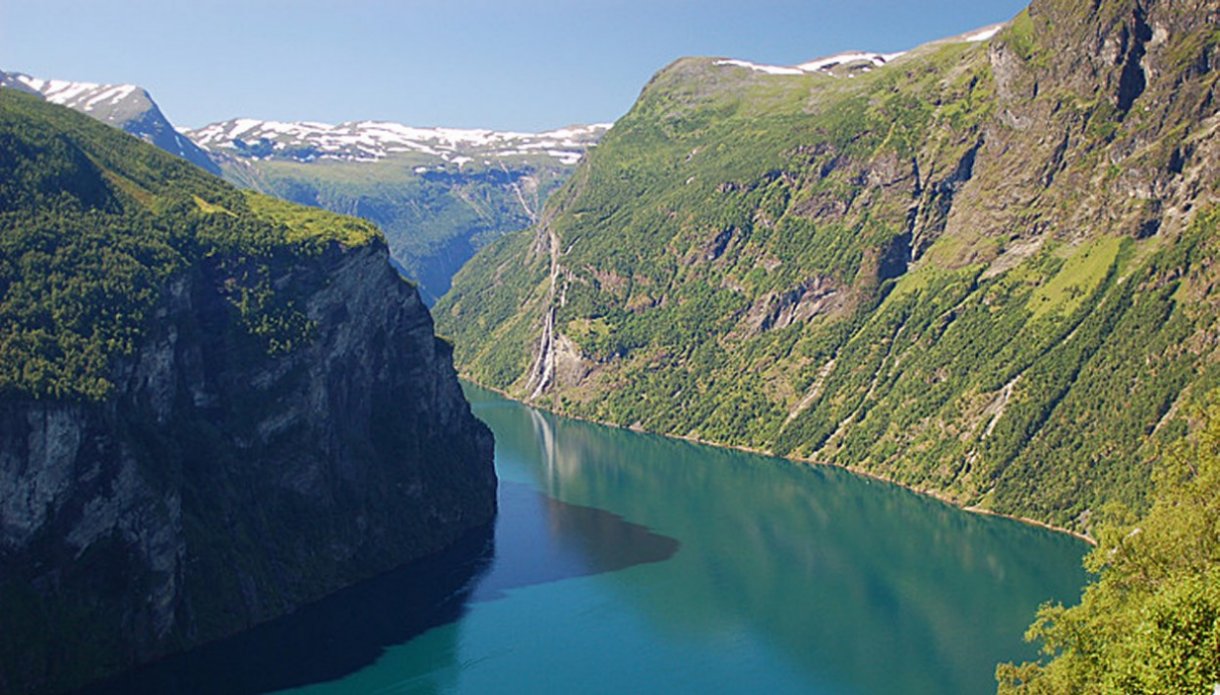 |
|
|
|
|
ABOUT
OUR 2010
OSLO CRUISE
|
MARLA ARCHER'S NOTE:
On May 6th, 2010,
we will set sail aboard The
Vision of the Seas,
one of
Royal Caribbean’s finest ships,
for a nine day trip across the North Sea of
Europe.
In 1998, SSQQ took its first summer Dance
Cruise. This trip marked the first
step in a summer tradition that quickly
became a huge success. Our summer cruise
trips were so much fun that people began to
ask me about other destinations. Good
idea! In 2004, starting with our Mardi
Gras Trip, I have organized one Destination
Cruise each year as well. By the way,
that Mardi Gras Trip remains a real favorite
of mine thanks to the wonderful group.
Amidst the insanity of Mardi Gras, our group
bonded together in a very real "Us against
the Mob" mentality. Feeling safe
within the protection of my group, I had as
much fun that day as on any trip we have
ever taken. That is the first time I
truly understood the dynamic energy inherent
in the group travel experience.
Since then, we have taken one incredible
trip after another - Alaska 2005, New
England 2006, Hawaii 2007, Eastern
Mediterranean 2008, and Western
Mediterranean in 2009. I am going to
tell you like it is - I got into this cruise
trip business because I wanted to see these
places just as much as you do. Now
thanks to our phenomenal
success on our most recent Barcelona cruise,
I decided it's time for an even more
ambitious trip. I am excited about my
first chance to take a look at Northern Europe tour with
our Oslo trip in May 2010.
I think I chose
well. Judging from the initial
responses I have received, barring the
unforeseen, this trip will be an
unparalleled success as well!
As most of you
know, with the end of our lease at the
Bellaire location in April 2010, we are
coming to the end of an era. As my
husband hands the reins of SSQQ The Next
Generation over to his successor Daryl
Armstrong, Rick is more than ready to sail
off into the wild blue yonder (me too!)
Rick and I both want to celebrate the next
chapter of our lives with more travel. Hence
this trip marks the perfect way to celebrate
the beginning of the next Era of SSQQ.
We would love for our friends and family to
join the fun. Hint - that means you.
It should be pretty easy to wrap your mind
around the incredible highlights of this
trip -
Oslo and
the Majestic
Fjords of Norway, Paris, long considered the
world's most romantic city, the beaches of
Normandy at Cherbourg, the stunning green
vistas of Dublin, the amazing Scottish Castles
of Edinburgh, and
finally a chance to see the mysterious Loch
Ness Monster (we are certain that Nessie
will make a special appearance just for us!)
|
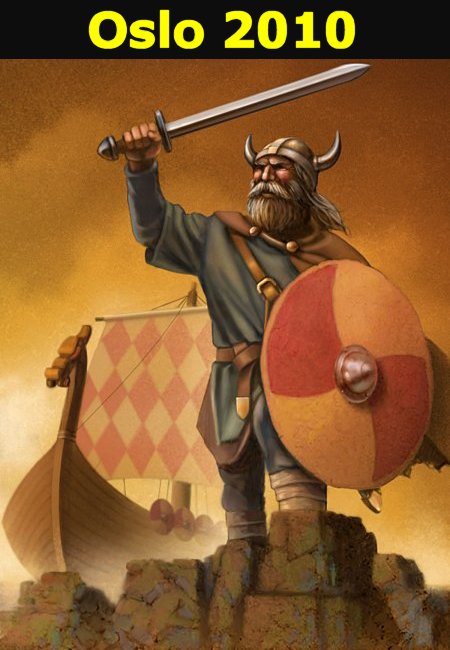 |
Please
come and share our adventure across the magnificent North
Sea.
This trip has everything - history, stunning natural beauty, rich culture and tradition,
dancing and, best of all,
friendship.
As always, you will be faced with tough
choices. Will it be a trip to explore ancient
ruins or an expedition to
witness spectacular mountain vistas? Is it a day at the
pub or a chance to enjoy the
compelling natural beauty
in Dublin?
Or will it be a chance to view
the
rich
architectural and historical heritage? Will you make a trip to
The Louvre or hit a nightclub at Moulin Rouge?
Can you
possible see all of Paris in a day (no, but
that won't stop you from trying!)
Don't worry, whatever you choose, you can't miss!!
This will be, yes, the trip of a lifetime.
By the way, I never get tired of saying that
-;) MA
|
|
|
May 06 - Oslo, Norway |
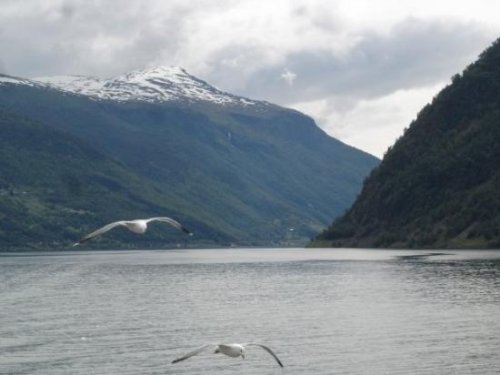 |
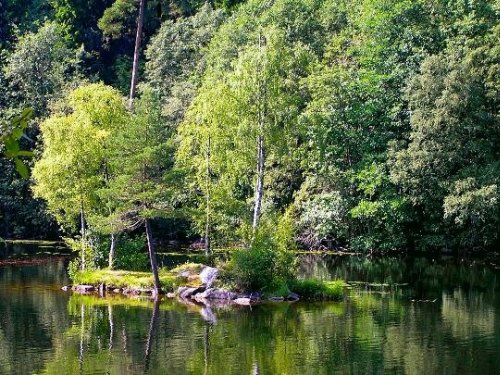 |
|
|
Oslo,
Norway |
Day One |
Our cruise departs
on Thursday from
Oslo, Norway at
5:00 pm
in the evening. Why not come a day or two early
to explore Oslo
in even greater depth?
Oslo
is a dynamic city. Fashionable shops fill the wide and
tree-lined Karl Johan Avenue. Cafes spill on to tree-shaded
footpaths. The population of 1.3 million is expanding
rapidly; the city nudges hills, forests and the Oslofjord,
creating a planning dilemma that only enhances the
cosmopolitan atmosphere.
Take a walk to Aker Brygge (pictured) a modern dockside development
for dinner. It could be part of an Australian coastal city
were it not for Akershus Fortress, the 16th-century castle
guarding the harbour. Two ordinary meals and two glasses of
wine will cost about $100. Tourists can begin to remedy
costs by purchasing an Oslo Card. An equivalent is available
in Bergen and these passes provide admission to many
attractions, public transport and discounts at a selection
of venues.
Head
for the National Gallery. Van Gogh, Monet and El Greco are
all represented in addition to the paintings of late
19th-century expressionist Edvard Munch, whose fame centres
on his disturbing work The Scream (pictured). Munch created many
versions of this enduring portrayal of a human face
distorted in a release of unbearable emotion. It perfectly
mirrors how the director of Oslo's Munch Museum must have
felt in 2004 when two prized and revered paintings, a
version of The Scream and Madonna, were audaciously plucked
off the gallery walls by thieves. Those wails of distress
were fuelled by chagrin, too, because the crime echoed a
previous heist. In 1994, the National Gallery's painting of
The Scream had also been stolen. The lesson finally hit
home: security systems in both galleries are now, as it
were, state of the art. Thankfully all the paintings were
eventually recovered and the anguished faces of Norwegian
gallery directors are once more composed.
A
breath of fresh air is essential after a Munch encounter.
Embark on a 15-minute ferry ride from City Hall to Bygdoynes
where there are three maritime museums, all close together.
Even if you are not crazy about seafaring history this is a
worthy excursion. Some splendid homes and gardens are found
in these wealthy streets and the waterfront is a relaxing
place to sit and munch a quick lunch.
At
Frammuseet one can board the robust 1892-built polar ship
Fram and see the cabins of Roald Amundsen and his crew,
their expeditionary possessions scattered about. This is the
vessel that took Amundsen to Antarctica so Robert Scott fans
might skip it. Nearby at the Kon-Tiki Museum
(pictured) are the many
handcrafted boats of adventurer-scientist Thor Heyerdahl, an
environmentalist before the word was known. The Kon-Tiki
astonishes with its apparent fragility, yet in 1947 this
balsa wood and bamboo craft took Heyerdahl and his crew from
Peru to the South Pacific.
An
equally worthy shrine to Norwegian seamanship is the Viking
Ship Museum (pictured), 10 minutes away. Here are three magnificently
preserved ninth-century grave ships that were buried with
the bodies and possessions of high-ranking people.
We will complete the nautical day by putting to sea in Johanna, an
old timber sailing vessel that takes tourists on three-hour harbour
cruises. We will pass by the glinting
new opera house and into the Oslofjord, where painted
cottages provide splashes of color on the hills and
shoreline.
If you
have the time, take the Bergen Railway on a four-hour
journey from Oslo to the high mountain town of Myrdal, 866m
above sea level. Here you will change from a slick modern
train into a 70-year-old standard-gauge rattler known as the
Flam Railway. It will descend on a gradient of 1:18 through
20km of thrilling countryside torn into green patches,
gashed by waterfalls and sheered off by upheavals. If you
prefer try a bike ride at Myrdal and ride down scenic paths
over ravines and past farms to Flam, a tranquil port located
on an arm of the Sognefjord.
This
deep fissure off the west coast of Norway is the world's
longest fjord, extending over 200km and reaching into
stunningly picturesque valleys. Arrive in Flam to find its
wharves filled with romantic tall sailing ships en route to
Bergen for the annual races. Boasting a surfeit of troll
marts bulging with ugly critters and other kitsch, this
commercialized hamlet caters mainly to cruise passengers.
Walking in the Flam Valley is a popular activity so fill a
morning with an easy ramble, following the course of the
rushing, tumbling river.
Time
permitting, visit Balestrand, a couple of hours from Flam by
high-speed ferry (May to September only), which lies right
on the Sognefjord. Ringed by snowy peaks, this community of
just 1800 permanent residents is blessed by such a
relatively moderate climate and fine scenery that tourists
have been coming here for two centuries. Kaiser Wilhelm II
made annual visits for 25 years until World War I. He loved
the region and the Norwegian people, whom he romanticised as
being of pure Germanic stock.
The
Kaiser stayed on his yacht while other tourists generally
sought out the famous waterfront Kivikness Hotel.
This white, Swiss-style mansion of fretworked timber has
been welcoming tourists for 140 years. It has belonged to
the Kivikne family for five generations, their shared
commitment to hospitality and the continuing upkeep of this
sprawling hotel is a story in itself. Grand public rooms
marry the style of English country house with Norwegian
hunting lodge.
After
exploring the immediate township (allow an hour if the
private art galleries are open), to wander by the fjord.
You will find a traditional stave church
(pictured at right) with a welcoming
atmosphere. Known locally as the English Church, it is a
memorial to Margaret Kivikne, the nature-loving daughter of
an English vicar. Since her death 115 years ago, visiting
Anglican clergy have held summer services for tourists.
One
good decision would be to visit the Jostedal Glacier, requiring a full or half-day excursion, or
take the morning ferry to Bergen.
The
four-hour ferry ride along the Sognefjord to Bergen is one
of the globe's great journeys, enhanced on this occasion by
craft of all sizes under sail. Be sure not to miss any of
this majestic scenery. The historic area, Bryggen, with its
toy-town row of timber warehouses, is hidden behind a forest
of masts festooned with flapping pennants. Bands, food and
souvenir stalls draw surging crowds.
While
visiting Bergen, stop by Grieg's home 8km south of town and
take the dizzying funicular ride to the top of Mt Floyen.
At the top, forested trails and a lake provide refuge from
the city while Bergen. You may choose to walk down but it
will be a long and steep hike. Bergen's 900-year history
was partly written by the Hanseatic League, an association
of German merchants and their apprentices who conducted
business all over Europe in the Middle Ages. This city was
one of their main bases.
The
merchants would have regarded the mass of vessels and
partying in an aloof mercantile way, because league members
lived dour, monastic lives when away from home. (Or so the
story goes. Prostitution was rife in this area.) Their
apprentices endured horrific hardships but many eventually
prospered. The league's living quarters have survived,
making for a fascinating tour that sets out from Bryggen
Museum.
The
true beauty of Norway will be found in tiny, ageless towns
fill with friendly townfolk where life advances against a
background of glassy fjords and peaceful mountains altered
only by the seasons.
We will have our SSQQ
Welcome Aboard party this evening. Meet your fellow
SSQQ Cruise passengers and dance to your favorite tunes as we sail across
the majestic North Sea.
|

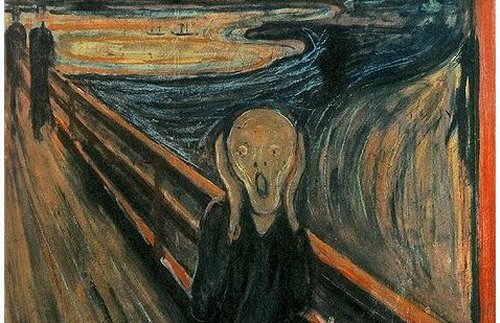
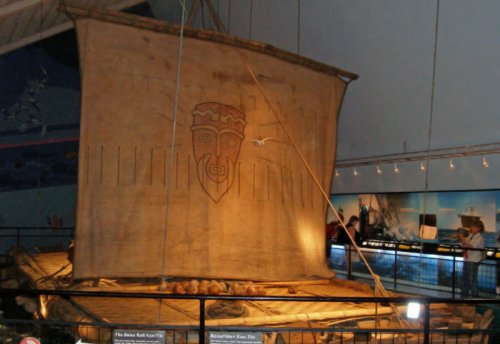
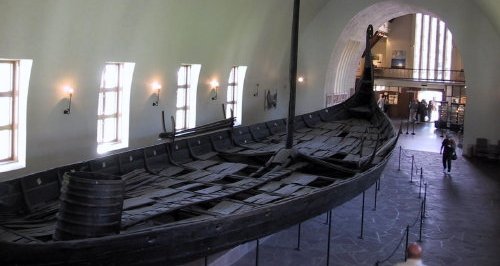
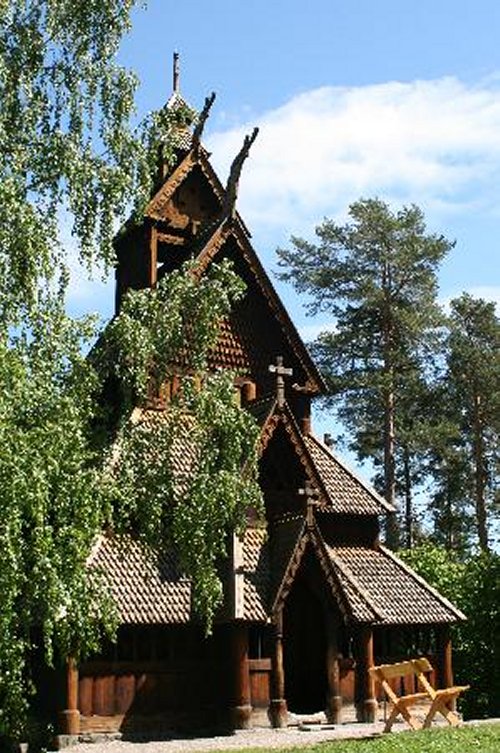
|
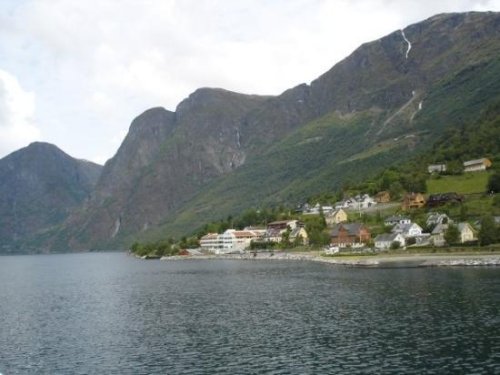 |
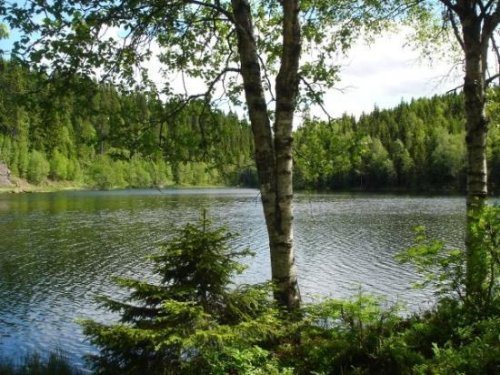 |
|
|
|
|
May 08 - Paris, France |
|
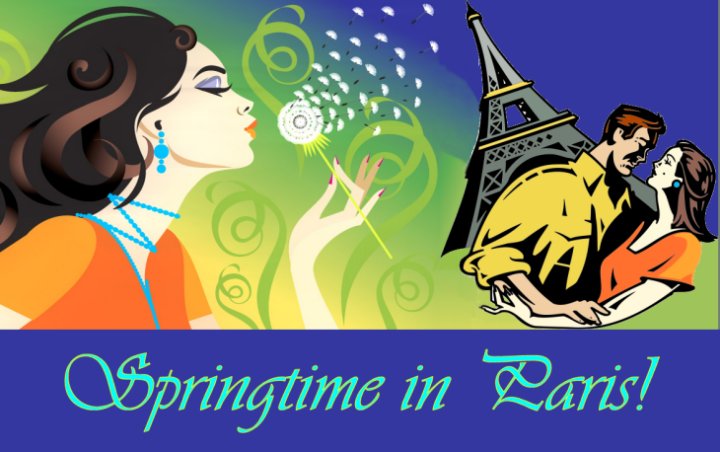 |
I Love Paris
Cole
Porter
I love Paris in the
spring time!
|
 |
I love
Paris
in the fall
I love Paris in the summer when it sizzles
I love Paris in the winter
when it drizzles
I love Paris every moment
Every moment of the year
I love Paris, why oh why do I love Paris
Because my love is here
|
|
OUR CHANCE TO VISIT THE
MOST ROMANTIC CITY IN THE WORLD!
Many people in our group have never
visited Paris. Add Rick and Marla into that category!
For us, this is the first
chance we have ever had to see this legendary destination.
Everyone tells us that Paris is the most romantic destination in
the world. We can't wait to find out why!
Our
ship will arrive at Le Havre at
9:00 am
on Saturday. Then we take the train to Paris.
Since we don't have to be back to the ship till midnight, we
have lots of time to explore and enjoy. For that
matter, you might even be allowed to spend the night in
Paris and catch up with the ship the next day in Cherbourg,
France. Le Havre is 170 miles from Paris.
Cherbourg is 190 miles from Paris. If there are trains
from Paris to Le Havre, then surely there are trains the
next day from Paris to Cherbourg, yes?
That neat little trick would give you nearly a full day and
a half in Paris.
Paris is definitely one of the world's most popular tourist
attractions, with 45 million tourists every
year coming to the Paris Region, 60% of whom are foreign.
There are numerous iconic landmarks such as the Eiffel Tower
among the many attractions of Paris. The list is practically
endless. There is the Notre Dame Cathedral, the Louvre
Museum, the Palace of Versailles, the lovely Seine River,
and popular parks such as "Le Bois de Boulogne". At
night, the city never sleeps thanks to rowdy venues at the
Moulin Rouge. There is so much to see that people have
reasons to visit again and again.
Paris is known as the "City of Lights",
a name it owes both to its fame as a center of education and
ideas as well as its early adoption of street lighting.
Paris is also considered the most romantic place of all to
visit. The "City of Love" has many beautiful parks,
street cafes, and long walks along the Seine that all help
make Paris the perfect place for lovers to frolic.
Home to more than 10 million people,
Paris is
majestic in its architecture and artistic heritage. More
than a destination of pleasurable externals, bourgeois
absolutes and just-baked baguettes, Paris is great
sightseeing, incredible shopping, and leisure dining that
always comes with desserts in the form of delicate trays of
the finest chocolates and macaroons.
Paris is so much more than the Eiffel Tower, the Arc de Triomphe, Notre-Dame and the Louvre.
Stroll
the Marais and shop along rue des Francs Bourgeois or walk
under the arches of the oldest square in Paris, Place des
Vosges. Take time to explore the Latin Quarter to see the
church of St. Severin, the Sorbonne and rue Mouffetard --
not just because it's where Joyce, Orwell, Balzac and
Hemingway once lived, but also for the rows and rows of
fresh food glistening like bouquets of colorful gems under
the street market's faded French blue-striped awnings. Stop
by the booksellers' stalls along the banks of the Seine
around Notre-Dame for antique and second-hand books, comic
strips, postcards and posters at great prices.
Saint Germain-des-Pres and the stately Church of St
Sulpice's beautiful Delacroix murals are a must-see this
trip -- as is the St. Germain Church, the city's oldest
church -- before heading down the neighborhood's enchanting
streets, through the old squares and artists' studios that
surround it. Don't forget to leave time to head up to the
little village of Montmarte and the old cobbled streets
where Renoir, Lautrec and van Gogh lived and worked; there
are wonderful views of the city.
Paris is basically divided twice, first into 20 municipal
quarters called arrondissements and second by the Seine,
which divides the city into the Right Bank to the north and
the Left Bank to the south, linked by 32 bridges. Two of
those bridges connect to two small islands at the heart of
the city: Ile de la Cite, the city's birthplace and site of
Notre-Dame, and Ile St-Louis, a moat-guarded oasis of
17th-century chateaux. The quarters spiral out like a snail,
beginning with the first arrondissement. Included in these
20 "neighborhoods" are well known areas like Montmarte,
Montparnasse and the Marais.
The best way to find an address is by checking out the
arrondissement first. This is indicated by a number followed
by "e" or "er," which in English means "th" or "st" (i.e.,
7e, 1er)
What to See
What weighs 7,000 tons and has 1,665 steps and 10,000 light
bulbs? The Eiffel Tower! This breathtaking landmark
was built by Gustave Eiffel (did you know he designed the
framework for the Statue of Liberty?) for the 1889 Universal
Exhibition to commemorate the centenary of the French
Revolution and was opened by the Prince of Wales, who later
became King Edward VII of England.
The Louvre is the world's greatest art museum -- so
it really doesn't matter if you've been here before since
there's no chance you've seen it all. Collections divide
into Asian antiquities, Egyptian antiquities, Greek and
Roman antiquities, sculpture, objets d'art, paintings, and
prints and drawings. Obviously, the top attractions (and
most likely the ones you've seen) are the "Mona Lisa" and
the 2nd-century "Venus de Milo."
Note: Avoid the never-ending lines to enter through
the Pyramid. Instead, come in from the Carrousel de Louvre
mall on rue de Rivoli or, even better, through the Louvre's
Metro stop.
(Rick Archer's Note: I have a
stunning collection of some of the magnificent artwork
displayed here on the SSQQ website. You really must
see it!
The Louvre)
Moulin Rouge has been putting on its famous show
since 1889. Of course, being immortalized by Henri
Toulouse-Lautrec and known for the risque can-can didn't
hurt either. It's still fabulous with plenty of feathers,
sequins and of course, gorgeous semi-naked showgirls. It's
open every night.
The 164-foot Arc de Triomphe was planned by Napoleon
to celebrate his military successes, but wasn't finished for
another 20 years after he took a trip to Elba. It has some
magnificent sculptures, and the names of Napoleon's generals
are inscribed on the stone facades. There is a small museum
halfway up the arch devoted to its history (you can actually
climb to the top). France's Unknown Soldier is buried
beneath, and the flame is rekindled every evening.
Although it's probably easier to take the elevator up to the
top of the Eiffel Tower, you can also climb 387 steps
up to the north tower of 12th-century Notre-Dame for
a nice view of the city. It was here in 1804 that Napoleon
crowned himself emperor and then crowned Josephine as his
empress. When planning your visit, keep in mind that the
cathedral is open year-round from 8 a.m. until nearly 7
p.m., but the towers and crypt are operated by the National
Monuments Centre and have more limited opening hours.
Musee d’Orsay is in fact a magnificent 1900 railway
station that now houses a superb collection of Impressionist
art from 1848 - 1914, including major works from Degas,
Monet, Renoir, van Gogh and Gauguin. If you don't have lots
of time, browse the Upper Level to see the enormous railway
clocks in addition to some of the museum's best exhibits.
There's little left of the Bastille, and its remains
are pretty much surrounded by a neighborhood filled with an
array of popular cafes, clubs and the Opera Bastille,
completed in 1990. The Colonne de Juillet dominates la Place
de la Bastille, marking the site of the prison that was
stormed at the start of the French Revolution in 1789.
In the 16th century, 30 windmills were built in Montmarte
for winemaking and milling grain, but only two remain today.
Wander the back streets, away from the main square and
souvenir shops. At dusk, sit on Basilica du Sacre-Coeur’s
top steps and watch Paris indeed become the City of Lights.
The basilica is dedicated to the Sacred Heart of Christ and
the crypt contains what many believe to be Christ's sacred
heart. By the way, when its 19-ton bell tolls, you not only
hear it -- you feel it!
Check out one of the city's off-the-beaten-path museums. The
Rodin Museum was once the home of Rodin and now
houses several of the artist's impressive collections,
including personal ones. The garden is as spectacular as the
inside, so leave time for both. Hotel des Invalides is the
magnificent 17th-century domed structure constructed under
the direction of Louis XIV to shelter old and wounded
soldiers; it's also the site of Napoleon's tomb. The Museum
of Jewish Art and History in the Marais is a wide-ranging
collection of objects dating as far back as the Middle Ages.
Head for the rue de Bac for smart shops and a bit of
neighborly biographic history. Edith Wharton lived around
the corner on the rue de Varenne at Nos. 53 and 58; the
Prime Minister's official residence is at No. 57 on Varenne.
The chapel of the Miraculous Medal, where Catherine Laboure
was said to have visions of the Virgin in 1830, is at No.
140.
Cite de l’Architecture et du Patrimoine which opened
in 2007, is the first and only permanent collection
dedicated to architecture and architectural heritage.
Designed by Jean-Louis Cohen and Jean-Francois Bodin, the
new museum showcases the collections of drawings, drafts and
models of the French Institute of Architecture.
The Bois de
Boulogne is a park located along the western edge of the
16th arrondissement of Paris, near the suburb of
Boulogne-Billancourt.
The Bois de Boulogne is a giant park that
is virtually a forest within a city. The park
covers an area of 3 1/2 square miles,
which is 2.5 times larger than Central Park in New
York. In addition to canoes for
romantic rowing in the lake, there are waterfalls and plenty
of trails through the wooded area for those hand in hand
strolls.
The Palace of
Versailles, or simply Versailles, is a royal château in
Versailles, the Île-de-France region of France. When
the château was built, Versailles was a country village;
today, however, it is a suburb of Paris, some 12 miles
southwest of the French capital. In addition to the
exquisite chateau, it is home to one of the most beautiful
gardens in all of France.
Where to Eat
In Paris, there are memorable dining experiences around
every corner -- from the melt-in-your-mouth croissants at a
sunny sidewalk cafe to the spectacular culinary creations at
the city's many Michelin-starred hot spots. If you're
looking to try one of the latter, be sure to make your
reservation well in advance, and consider a lunchtime visit
to enjoy similar gourmet cuisine at more affordable prices.
A few tips for dining in Paris: The city's restaurants,
cafes and bars are now non-smoking, at least indoors -- as a
result, outdoor patios are now smokier than ever. When
looking at your bill, keep in mind that the tip is often
included; however, it's customary to leave a few extra Euros
if the service was particularly good. Keep an eye out for
the phrase "service non compris," which means that the tip
has not been included; in this case, leave about 15 percent.
Les Bouquinistes, Guy Savoy's trendy Left Bank
bistro, is located near Notre-Dame and offers elegant French
cuisine such as grilled royal sea bream with zucchini and
antiboise sauce, and pan-seared foie gras with salty crumbly
shortbread and cherries.
The combination of its Eiffel Tower location and spectacular
food makes Le Jules Verne one of the most popular
(and expensive) restaurants in Paris. Make your reservations
months in advance (though it's a bit easier to land a table
at lunchtime).
Pierre Herme is the city's premier pastry chef. We
love the glorious macaroon confections in pistachio, coffee,
rose, passionfruit-chocolate, lemon-hazelnut and the like.
The stylish Le Martel (3 rue Martel) serves up a
delicious mix of French and Moroccan cuisine to a trendy
clientele in the 10th arrondissement.
You can have ... er, buy your foie gras and eat it too at
Granterroirs (30 rue de Miromesnil). Add truffles and
other similar goodies for a memorable light lunch.
Passionate or casual tea drinkers should head straight for
Mariage Freres, which sells more than 500 types of
tea and has been in business since the 1800's.
It's worth heading a little bit out of town to dine at
L’Atelier du Parc, where the gourmet French fare is
moderately priced. The restaurant is easily accessible by
Metro.
At Angelina, chocolate bars are melted down to thick
syrup in the name of hot chocolate. And don't miss the
amazing Mont Blanc gateau.
Where to Shop
Paris is
a shopper's paradise. Serious shoppers who want to make the
most of their time in Paris should take a shopping tour;
several companies, including Chic Shopping Paris and Paris
Luxury Tours offer different options. "Merci" should always
precede a departure from any shop, whether you were helped
or not -- and a "bonjour" upon entering is always
appreciated.
In France, a sales tax or VAT is tacked on to most
purchases; however, non-E.U. citizens who spend at least 175
euros at a participating store can get the VAT refunded
(with some exceptions).
Note: Refunds are almost non-existent, so shop
mindfully. In most department stores, you will be handed a
"bill" to pay at the cashier (sometimes a long walk away)
before getting your items. By French law, sales take place
twice yearly (January, July). They're amazing and the long
lines form outside the swankiest shops on day one. To avoid
fines, some stores (mostly department stores) mark some
racks as "specials" or "just in," but it isn't all that
common.
Visit Avenue Montaigne in the eighth arrondissement
for haute couture from the likes of Chanel, Laurent, Dior
and Lanvin.
Marche aux Puces St-Ouen de Clignancourt, the most
famous flea market in the city, is enormous -- consisting of
some 3,000 stalls. It's held along Avenue de la Porte de
Clignancourt Saturday through Monday.
Rue du Faubourg St-Honore pays homage to glamour,
fashion, high style and the world's most expensive shops and
galleries -- and the President's Palace.
The Champs-Elysees is one long promenade of high-end
shopping opportunities, including names like Prada, Sephora
and Louis Vuitton.
Many visitors are surprised to hear that Paris has a
Chinatown, but it's actually a fun place to shop. Browse
the aisles at giant Asian supermarkets along avenue d'Ivry
such as Tang Freres packed with dried mushrooms, Vietnamese
lemongrass, canned litchi juice and powder water chestnuts.
It's a must-do for finding those ingredients you can never
seem to find for a recipe (as long as it's canned or sealed,
you can get it thru Customs back home
|


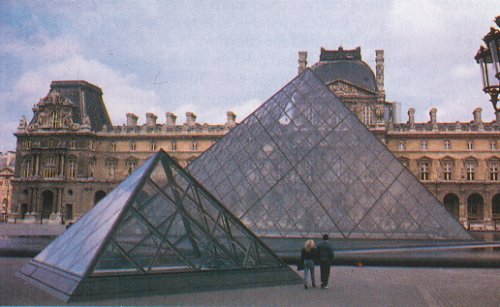
The Louvre

Notre Dame
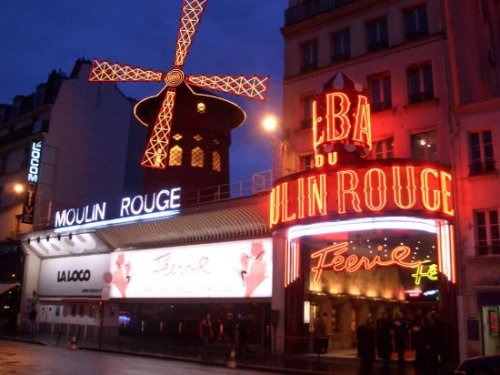
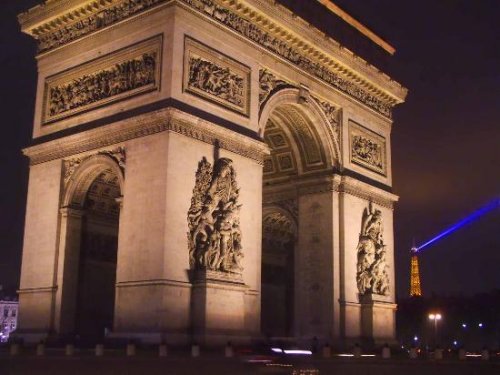
Arc de Triomphe
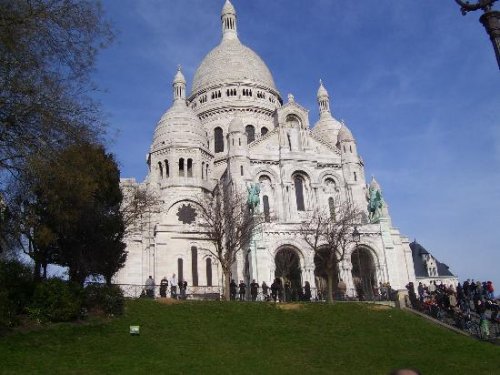
Basilique Sacre Coeur
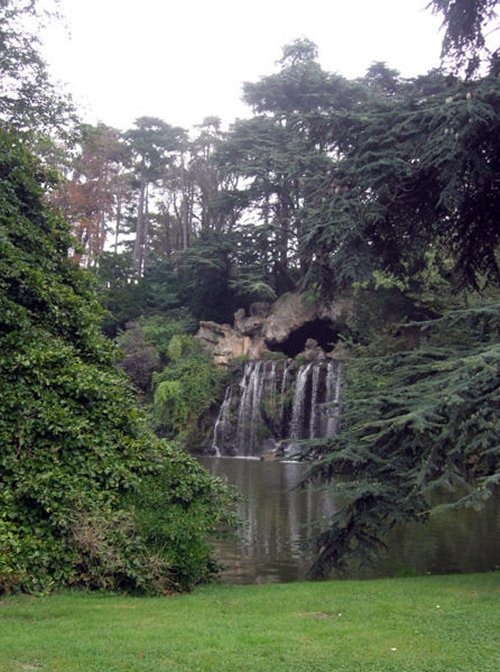
Bois de Boulogne
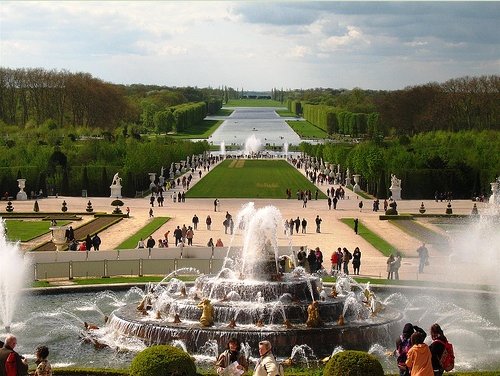
Gardens at the Palace of Versailles |
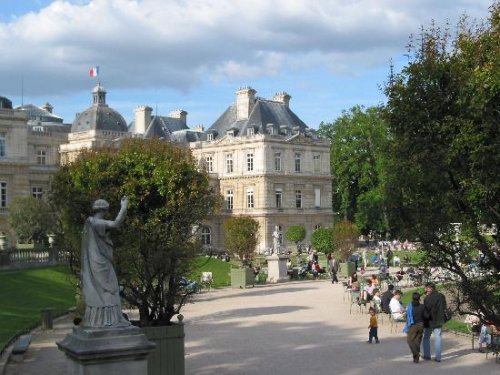
Palace at Luxemburg |
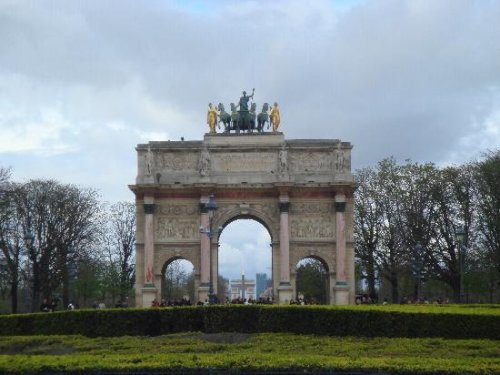
Arc de Triomphe du Carrousel |
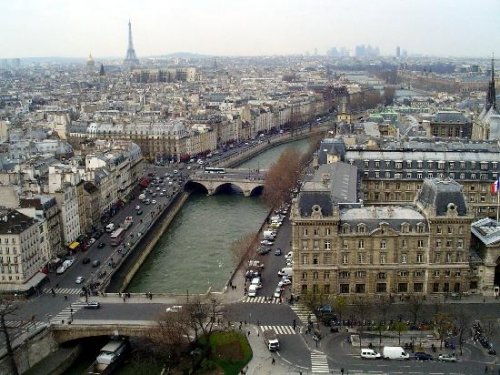
The Seine River runs through the heart of Paris |
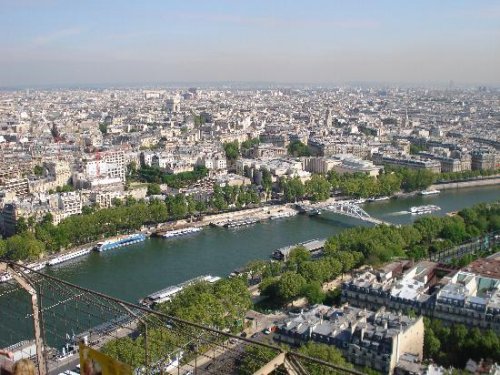
Another look at the beautiful Seine River |
|
|
Cherbourg,
France |
|
|
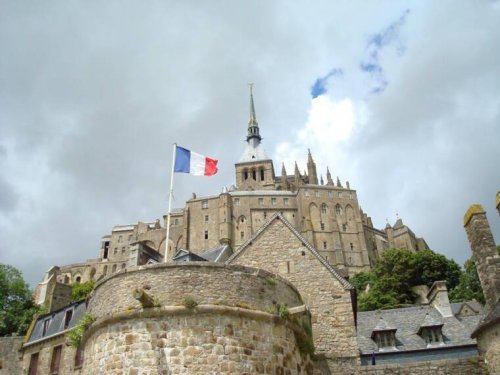
Fort du Roule |
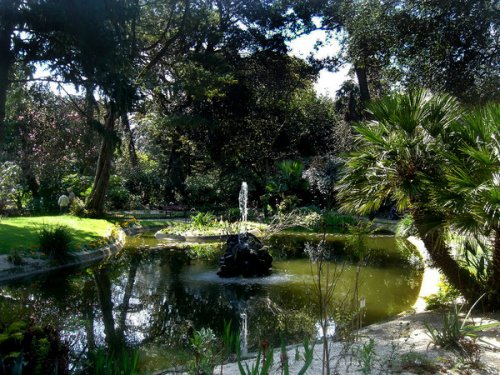
Park Emmanuel in Cherbourg |
|
|
Cherbourg, France |
Day Four |
Cherbourg is a city in France,
situated in the Normandy region northwest of
Paris. An
important city for its harbor and its proximity to French
cities of note, it is also a busy deep-water seaport, naval
base and maritime industrial center.
An exploration
of this port city offers natural beauty and
impressive manmade landmarks, from spectacular sea vistas
and verdant hills to a massive sea wall that rims its harbor
and a star-shaped fort that guards it.
Things to See and Do
Fort du Roule—a
classic 19th-century fortress built atop a steep hill
overlooking Cherbourg—houses a WWII museum that's not to be
missed. And visitors preferring the outdoors will find
plenty of gardens in the city of Cherbourg that bloom with
color year-round. They are beautiful settings in which to
spend a leisurely afternoon.
The
Jardin Public
is an incredible public park that sits at the
foot of Roule Mountain and offers a large aviary; a sea pool
with sea lions and a children's play area.
D-Day.
For
the history buffs, Cherbourg
is situated close to sites of incredible
historical importance.
A visit to Cherbourg offers a chance to learn more about
D-Day
and
to see the actual landing site.
The
Normandy beaches,
where Allied invasion took place
on D-Day, are only 30 miles away. There
are certain to be excursions that will take you to this
site of historical importance.
In addition, the Battle of
Cherbourg was part of the Battle of Normandy during World
War II. It was fought immediately after the successful
Allied landings on June 6, 1944. American troops isolated
and then captured the fortified port, considered vital to
the campaign in Western Europe, in a hard-fought campaign of
three weeks.
Past and Present
Though
tranquil and idyllic today, the area that is now Cherbourg
has a fascinating history of conflict and conquest. Even
before World War II, the city saw a string of invasions.
Over the centuries, it has been home to different groups of
people, including Celts, Gauls and Romans. Saxons have also
invaded the area, followed by the Franks and Vikings, many
of who settled there.
With the Norman conquest of England in1066 AD, Cherbourg
came under English rule for nearly 300 years. In the 13th
century, it became part of the Kingdom of France, later to
change rule over and over again during the Hundred Years
War. In all, Cherbourg changed hands between England and
France 6 times, until 1540 AD, when it became a permanent
part of France.
|
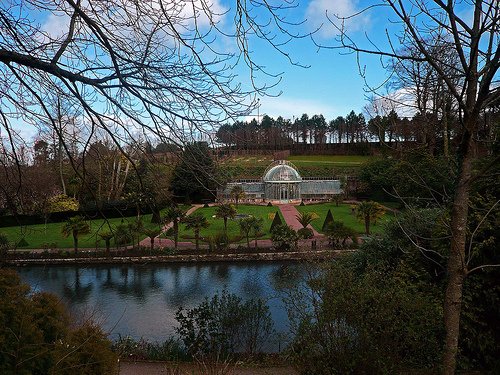
The aviary at Jardin Park in Cherbourg
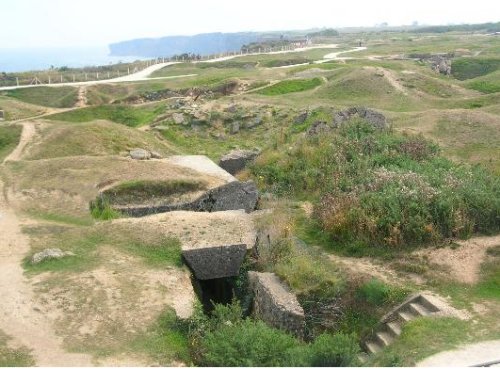
A bunker at Omaha Beach in Normandy |
Rick Archer's Note about
Cherbourg: On September 15, 2009, I
received a publicity email that touted the top 25
cities to visit in France. Curious, I took a
peek. Alas, Cherbourg wasn't among them.
So the big question is - Why
would a major cruise line visit Cherbourg when Paris
is just down the street?
I assume
the reason is that Cherbourg offers people the
perfect chance to walk the beaches of Normandy and
see first-hand the places where the Allies landed at
D-Day.
I am
well aware that no one who reads my travel write-ups
needs me to explain the significance of D-Day to
them. So I will not insult your intelligence
with a long-winded recap. That said, I hope
you won't mind if I say a word or two.
The Invasion of Normandy on June 6, 1944, was by far
the largest amphibious operation in history. Known
as D-Day, this remarkable event marked
the beginning of the end for Germany in World War
II.
The
Normandy landings were the first successful
"opposed" landings across the English Channel in
over eight centuries. The attack was very costly in
terms of men, but the defeat inflicted on the
Germans was one of the largest of the war.
Strategically, the campaign led to the loss of the
German position in most of France. In larger
context, the Normandy landings also helped the
Soviets on the Eastern front, who were facing the
bulk of the German forces. There is little
doubt that D-Day contributed to the shortening of
the conflict there as well.
Contrary
to what some people say, the Germans weren't stupid.
They knew full well from the Allied build-up across
the channel in England that the invasion was coming.
Accordingly, the Germans put tremendous energy into
building up their defenses along the coast of
France.
One of the remarkable features of D-Day was just how
successful the Allies were at duping the Germans
into believing the main thrust would come at Calais
(see picture). Even after the assault on
Normandy began, much of the German high command
still believed this attack was just a fake to divert
forces away from Calais. Field Marshall von
Rundstedt screamed at his Nazi superiors to allow
him to move the vaunted Panzer divisions at his
disposal down to Normandy, but he was not permitted
to commit the armored reserve for several hours.
When it was finally released late in the day, any
chance of repelling the attack was lost.
So, thanks to the ingenuity of the Allied command,
the resistance they did face at Normandy was
diminished. That still didn't make it easy.
As everyone knows, the GIs had to slog through water
completely exposed to enemy machine guns pouring out
thousands of bullets per second. Then they had
to crawl across the sandy beaches of Normandy
without cover. Half the time they were pinned down
eating sand as the deadly fire raked the beaches.
Just imagine the fear these young men had to feel in
such a helpless position! Finally, they had to
literally scale cliffs to get to the enemy bunkers
and begin the attack - with a hail of bullets
whizzing past their ears scaring them to death the
entire time.
For this reason alone, the willingness of these
brave men to risk their lives against all odds ranks
this attack right along with the Spartans of
Thermopylae as one of the greatest displays of
courage in human history. These men certainly
get my vote as the greatest heroes of my time here
on Earth. I admire their courage tremendously.
You might be amused to know I spent half a morning
searching the Internet for pictures of the men as
they lay pinned down on the beach with bullets
flying overhead. I was also looking for
pictures of men scaling the Normandy cliffs as the
Germans tried to shoot them down from above. I
was frustrated at my inability to find these graphic
pictures. That's when it occurred to me that
any man in a position to take a picture like that
was more likely to have a gun in his hand than a
camera. That's when I realized it is
ridiculous how little I understand what these men
really went through. If I were to ask one of
these guys what really happened that day, I am sure
they would look at me and say, "Son, you have no
idea." Exactly.
Although naturally you and I focus on the Americans
who bravely served their country in this fight, the
people who had the most to lose were the British.
Hitler was determined to invade Great Britain.
Because the British channel stood in the way of
invasion by land forces, the Germans thought they
could soften up the UK population by indiscriminate
bombing. Thanks to this reign of terror, 60,000
people died and the United Kingdom was decimated
with senseless destruction.
When D-Day finally arrived, you don't suppose the
attacking British forces had a score to settle?
Interestingly, with their successful assault at
Normandy, the British settled yet another score as
well. For you history buffs, you may recall
the Norman Invasion of England led by William the
Conqueror in 1066 AD.
Today in the British cemetery at Normandy you can
read the inscription: "We,
once conquered by William,
have now set free the Conqueror's native land"
|
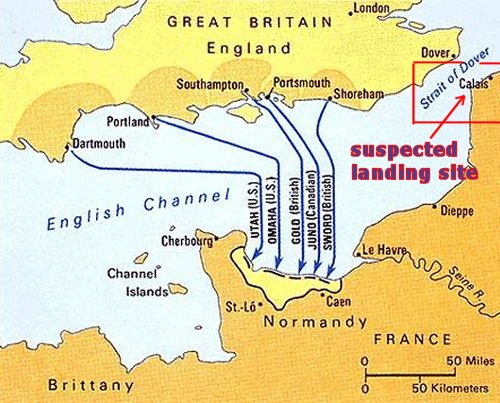
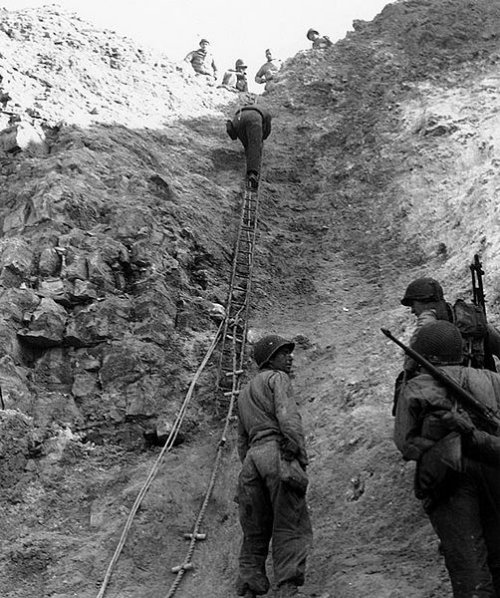
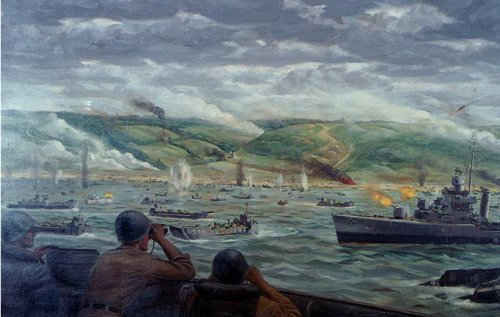 |
|
|
|
|
|
Dublin,
Ireland
|
Day Five |
Dublin is the capital of Ireland as well as
its largest city. The anglicized name comes from the Irish
Dubh Linn meaning "black pool". It is located
near the midpoint of Ireland's east coast, at the
mouth of the River Liffey and at the centre of the
Dublin Region. Originally founded as a Viking
settlement, it evolved into the Kingdom of Dublin
and became the island's primary city following the
Norman Invasion. Today, it is ranked 10th (up from
13th in 2008) in the Global Financial Centres
Index. Dublin has one of the fastest growing
populations of any European capital city, and is
ranked amongst the top 25 cities in the world.
The River Liffey divides Dublin. On the north side
of the Liffey is O'Connell Street - the main
thoroughfare, which is intersected by numerous
shopping streets, including Henry Street and Talbot
Street. On the south side are St. Stephen's Green,
Grafton Street, Trinity College, Christ Church and
St. Patrick's Cathedrals, and many other
attractions.
St.
Patrick's Cathedral
is the second of the capital's two Protestant
cathedrals. The other is Christ Church, and the
reason Dublin has two cathedrals is because St.
Patrick's originally stood outside the walls of
Dublin, while its close neighbor was within the
walls and belonged to the see of Dublin. Legend has
it that in the 5th century, St. Patrick baptized
many converts at a well on the site of the
cathedral. The original building, dedicated in 1192
and early English Gothic in style, was an
unsuccessful attempt to assert supremacy over Christ
Church Cathedral. At 305 feet, this is the longest
church in the country, a fact Oliver Cromwell's
troops—no friends to the Irish—found useful as they
made the church's nave into their stable in the 17th
century. They left the building in a terrible state;
its current condition is largely due to the
benevolence of Sir Benjamin Guinness—of the brewing
family—who started financing major, restoration work
in 1860.
Make sure you see the
gloriously heraldic Choir of St. Patrick's, hung
with colorful medieval banners, and find the tomb of
the most famous of St. Patrick's many illustrious
deans, Jonathan Swift, immortal author of
Gulliver's Travels, who held office from 1713 to
1745. Swift's tomb is in the south aisle, not far
from that of his beloved "Stella," Mrs. Esther
Johnson. Swift's epitaph is inscribed over the
robbing-room door. W.B. Yeats—who translated it
thus: "Swift has sailed into his rest; Savage
indignation there cannot lacerate his
breast"—declared it the greatest epitaph of all
time. Other memorials include the 17th-century Boyle
Monument, with its numerous painted figures of
family members, and the monument to Furlough
O’Carroll, the last of the Irish bards and one of
the country's finest harp players. Immediately north
of the cathedral is a small park, with statues of
many of Dublin's literary figures and St. Patrick's
Well. "Living Stones" is the cathedral's permanent
exhibition celebrating St. Patrick's place in the
life of the city. If you're a music lover, you're in
for a treat; matins (9:40 AM) and evensong (5:45 PM)
are still sung on many days.
Stephen's Green is a verdant, 27-acre
Southside square that was used for the public
punishment of criminals until 1664. After a long
period of decline, it became a private park in
1814—the first time in its history that it was
closed to the public. Its fortunes changed again in
1880, when Sir Arthur Guinness (a member of the
Guinness brewery family who was later known as Lord
Ardiluan), paid for it to be laid out anew. Flower
gardens, formal lawns, a Victorian bandstand, and an
ornamental lake with lots of waterfowl are all
within the park's borders, connected by paths
guaranteeing that strolling here or just passing
through will offer up unexpected delights (such as
palm trees). Among the park's many statues are a
memorial to W. B. Yeats and another to Joyce by
Henry Moore, and the Three Fates, a dramatic
group of bronze female figures watching over human
destiny. In the 18th century the walk on the north
side of the green was referred to as the Beaux Walk
because most of Dublin's gentlemen's clubs were in
town houses here. Today the legendary Shelbourne
hotel dominates it. On the south side is the
alluring Georgian-gorgeous Newman House.
Trinity College was founded in 1592 by Queen
Elizabeth I to "civilize" (Her Majesty's word)
Dublin. Trinity is Ireland's oldest and most famous
college. The memorably atmospheric campus is a must;
here you can track the shadows of some of the noted
alumni, such as Jonathan Swift (1667-1745), Oscar
Wilde (1854-1900), Bram Stoker (1847-1912), and
Samuel Beckett (1906-89). Trinity College, Dublin
(familiarly known as TCD), was founded on the site
of the confiscated
Priory of All Hallows.
For centuries Trinity was the preserve of the
Protestant Church; a free education was offered to
Catholics—provided that they accepted the Protestant
faith. As a legacy of this condition, until 1966
Catholics who wished to study at Trinity had to
obtain a dispensation from their bishop or face
excommunication.
Grafton
Street
is no more than 200 yards long and about 20 feet
wide, but this brick-lined street, open only to
pedestrians, can claim to be the most humming street
in the city, if not in all of Ireland. It's one of
Dublin's vital spines: the most direct route between
the front door of Trinity College and St. Stephen's
Green, and the city's premier shopping street, with
Dublin's most distinguished department store, Brown
Thomas, as well as tried and trusted Marks &
Spencer. Grafton Street and the smaller alleyways
that radiate off it offer dozens of independent
stores, a dozen or so colorful flower sellers, and
some of the Southside's most popular watering holes.
In summer, buskers from all over the world line both
sides of the street, pouring
out the sounds of drum,
whistle, pipe, and string.
O’Connell Street is Dublin's most famous
thoroughfare. It is 150 feet wide and was previously
known as Sackville Street, but its name was changed
in 1924, two years after the founding of the Irish
Free State. After the devastation of the 1916 Easter
Uprising, the Northside Street had to be almost
entirely reconstructed, a task that took until the
end of the 1920s. At one time the main attraction of
the street was Nelson's Pillar, a Doric column
towering over the city center and a marvelous
vantage point, but it was blown up in 1966, on the
50th anniversary of the Easter Uprising. A major
cleanup and repaving have returned the street to
some of its old glory. The large monument at the
south end of the street is dedicated to Daniel
O'Connell (1775-1847), "The Liberator," and was
erected in 1854 as a tribute to the orator's
achievement in securing Catholic Emancipation in
1829. Seated winged figures represent the four
Victories—Courage, Eloquence, Fidelity, and
Patriotism—all exemplified by O'Connell. Ireland's
four ancient provinces—Munster, Leinster, Ulster,
and Connacht—are identified by their respective
coats of arms. Look closely and you'll notice that
O'Connell is wearing a glove on one hand, as he did
for much of his adult life, a self-imposed penance
for shooting a man in a duel. But even the great man
himself is dwarfed by the newest addition to
O'Connell Street: the 395-foot-high Spire was built
in Nelson's Pillar's place in 2003, and today this
gigantic, stainless-steel monument dominates the
street.
Dublin
provides a beautiful setting: it loops around the
edge of Dublin Bay and on a plain at the edge of the
gorgeous, green Dublin and Wicklow mountains, which
rise softly just to the south. From the famous Four
Courts building in the heart of town, the sight of
the city, the bay, and the mountains will take your
breath away. From the city's noted vantage points,
such as the South Wall, which stretches far out into
Dublin Bay, you can nearly get a full measure of the
city. From north to south, Dublin stretches 10 miles
in total, it covers 28,000 acres—but Dublin's heart
is far more compact than these numbers indicate.
Like Paris, London, and Florence, a river runs right
through it. All the major sights are well within
less than an hour's walk of one another.
Phoenix Park is Europe's largest public park,
which extends about 3 miles along the Liffey's north
bank, encompasses 1,752 acres of verdant green
lawns, woods, lakes, and playing fields. Old-fashioned gas lamps
line both sides of Chesterfield Avenue, the main
road that bisects the park for 4 km (2½ mi), which
was named for Lord Chesterfield, a lord lieutenant
of Ireland, who laid out the road in the 1740s. To
the right as you enter the park is the People's
Garden, a colorful flower garden designed in 1864.
Famous for its literary tradition, Ireland's capital
has been home to writers from Jonathan Swift to
William Butler Yeats and James Joyce. A visit to
Dublin allows you to explore both the historical and
the hip, from castles and churches to cafés and
clubs. Those in search of the perfect pint need look
no further than one of Dublin's thousand pubs. The
vibrant city life brims with traditional Irish
culture and trendy European cool - all set against
the backdrop of its stunning coastline.
One of
the world’s liveliest cities, there’s been a buzz
about Dublin for centuries. While some tales of the
city and its residents are clichéd, many ring true.
Dubliners are a friendly and talkative bunch.
No visit to Dublin would be complete without
spending time in some of the city’s one
thousand-plus pubs. A Dublin pub is an excellent
place to experience the craic – that
quintessentially Irish sense of bonhomie that
improves as the evening wears on and the glasses
empty. Dublin has pubs to suit every taste, from
Victorian gems to 21st-century wannabes, elegant
lounge bars to spit-and-sawdust dives. There are
bars for the early morning and the late night, for
listening to music or watching the big match, for
soaking up literary history or indulging in quiet
conversation; bars for a quick tipple, a long lunch
or a whole evening’s drinking.
The
Guinness Brewery is Ireland's all-dominating
brewery. It was founded by Arthur Guinness in 1759,
and at one time was the largest stout-producing
brewery in the world. It spans a 60-acre spread
west of Christ Church Cathedral. Not surprisingly,
it's the most popular tourist destination in
town—after all, the Irish national drink is Guinness
stout, a dark brew made with roasted malt. The
brewery itself is closed to the public, but the
Guinness Storehouse is a spectacular attraction,
designed to woo you with the wonders of the "dark
stuff." In a 1904 cast-iron-and-brick warehouse, the
museum display covers six floors built around a
huge, central glass atrium. Beneath the glass floor
of the lobby you can see Arthur Guinness's original
lease on the site, for a whopping 9,000 years. The
exhibition elucidates the brewing process and its
history, with antique presses and vats, a look at
bottle and can design through the ages, a history of
the Guinness family, and a fascinating archive of
Guinness advertisements. The star attraction is
undoubtedly the top-floor Gravity Bar, with
360-degree floor-to-ceiling glass walls that offer a
nonpareil view out over the city at sunset while you
sip your free pint.
The temperature in Dublin does not vary wildly by
season, nor does the propensity to rain. Cool, wet
summers and mild, wet winters are the hallmark of
Dublin’s climate. The capital boasts a bevy of free
museums. A crop of upscale bistros concocts
innovative takes on Irish cuisine, and pubs
serve excellent food. A constantly evolving
arts scene is the city’s lifeblood. There’s always
something happening in Dublin.
Blarney Castle (pictured)
is a medieval stronghold in Blarney, near
Cork, Ireland, and the River Martin.
It is about 140 miles from
Dublin. The noted Blarney Stone is
found here at this castle.
The castle is now a partial ruin with some
accessible rooms and battlements. At the top of the
castle lies the Stone of Eloquence, better known as
the Blarney Stone. Tourists visiting Blarney
Castle may hang upside-down over a sheer drop to
kiss the stone, which is said to give the gift of
eloquence. There are many legends as to the
origin of the stone, but some say that it was the
Lia Fáil—a magical stone upon which Irish kings were
crowned.
Surrounding the castle are extensive gardens. There
are paths touring the grounds with signs pointing
out the various attractions such as several natural
rock formations which have been given fanciful
names, such as Druid's Circle, Witch's Cave and the
Wishing Steps.
Blarney House, also open to the public, is a
Scottish baronial-style mansion that was built on
the grounds in 1874.
|
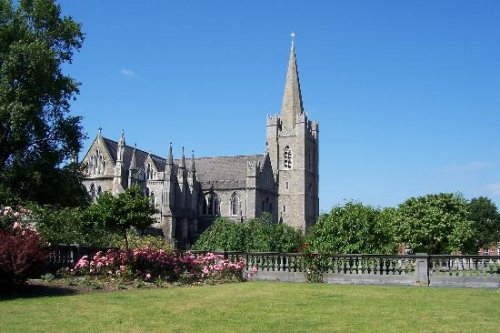
Saint Patrick's Cathedral
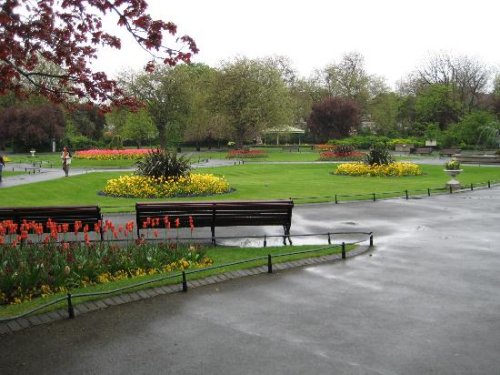
Stephen's Green
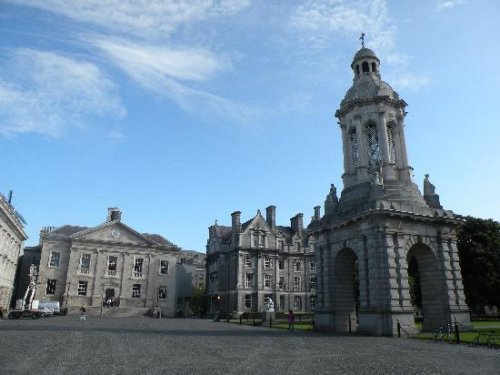
Trinity College
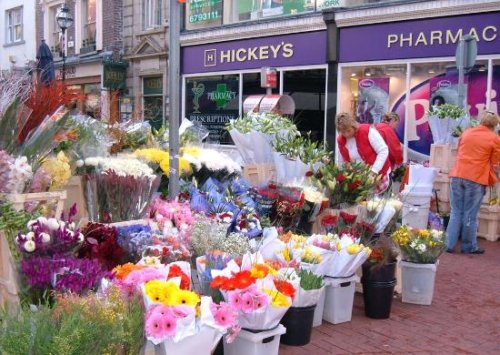
Grafton Street
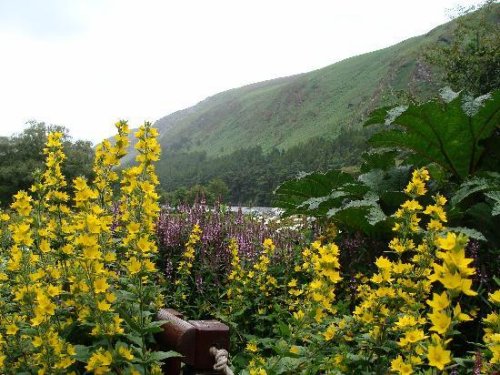
Wicklow Mountain
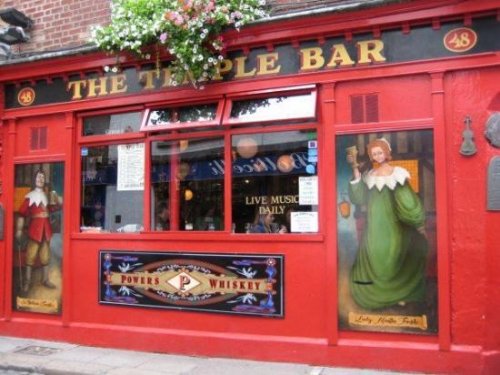
Temple Bar, Dublin's most famous pub
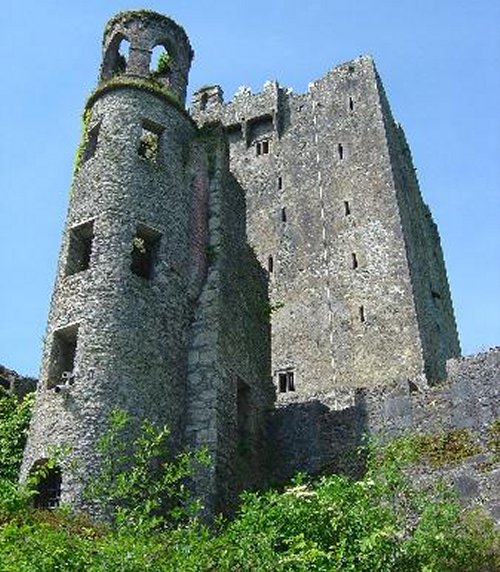 |
|
|
|
Edinburgh,
Scotland |
|
|
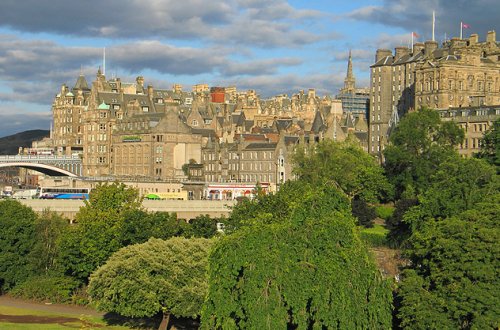
Old Town Edinburgh |
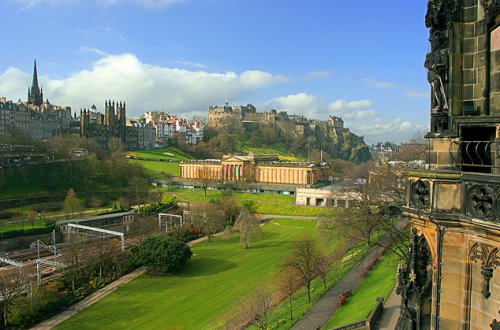
Edinburgh Castle |
|
Edinburgh,
Scotland |
Day Seven |
Edinburgh is
Scotland's
capital and second-largest city after
Glasgow. Its dramatic windswept
hills make it a site to behold. Edinburgh is known for
its arts festivals and Hogmanay celebrations, where
hundreds of thousands of people come to ring in the New
Year.
Edinburgh
is considered one of the most beautiful capitals in Europe. Its
distinctive and unique skyline follows closely that of
Venice and makes for fantastic photography at dusk or
dawn.
The historic City of Edinburgh preserved over the years
has its own medieval atmosphere. Every corner of the
city has its own story -- or legend -- which awaits to
be uncovered. For example, no tourist should miss a
visit to the vaults beneath the City which uncover
spooky stories of ghosts and mystery.
Kirkyard is the Scottish term for 'churchyard' and
Edinburgh has plenty of them. Each has countless stories
to tell, grave stones and mausoleums in honour of famous
individuals -- the economist Adam Smith, Robert Louis
Stevenson and the world's worst poet, William
McGonagall.
Greyfriars is possibly Edinburgh's most famous
churchyard thanks to Greyfriars Bobby, the terrier who
sat by his master's grave for years until his own death.
All tourists take pictures with Bobby's statue just
outside the kirkyard.
Despite its well preserved history, Edinburgh is by no
means medieval. The year-round events -- like the
Edinburgh Festival, the Edinburgh Military Tattoo and
the Edinburgh Hogmanay -- make it a vibrant city and can
be quite overwhelming for a tourist dying to cover it
all.
Built on the site of extinct volcanoes on the Firth of
Forth, Edinburgh’s Old Town is filled with cobbled
laneways and atmospheric Gothic buildings, while the New
Town boasts handsome streets and elegant treed squares.
The Old Town’s oldest building is over a thousand years
old, while the
New Town dates back only to the 1800s.
But it’s not all about the past. Edinburgh is also a
cosmopolitan city, with world-class restaurants,
scintillating nightlife and every type of hotel
imaginable. While the Castle looms on its crag at the
top of the Royal Mile, the uber-modern Scottish
Parliament building sits at the opposite end of the
mile-long cobbled street.
Since we are
visiting in the spring it will offer us the opportunity
to see Edinburgh without the hordes of tourists that
threaten to overrun the city in high season.
For first time visitors to Edinburgh take one of the
hop-on-hop-off buses around the City. It is an ideal
way to see a good selection of Edinburgh - which is
quite spread out and built on hills. There are four
different bus tours with varying routes. Check to make
sure the one you book goes to the sites you want to see.
The Royal Mile is the historic spine of the city,
running from the Castle at its highest point to the
Palace of Holyroodhouse at the bottom. In between there
are lots of significant historic sites and lots of cafes
and souvenir shops. If you are short of time do not
walk all the way down the Royal Mile. Enjoy the
Castle at one end, and
hop on a bus
to Holyrood at the other.
Alternatively, keep in mind that Edinburgh is a walker's
city.
Get right off the ship at 900
am and head for the Palace of Holyroodhouse
(opens at 9:30). If there is a good exhibit at the new
and beautiful Queen’s Gallery, buy a combination
ticket and see the exhibit there first, then with your
audio guide, tour the Palace and the Abbey ruins at your
own pace. Don't neglect a short stroll in the Palace
gardens after your tour. They are pretty and well kept.
Then walk slowly uphill toward Edinburgh Castle
stopping on the way to look at John Knox’s house and,
and St. Giles Cathedral; go inside these sights or
not, as your whim takes you. Peek into the Closes
(small pedestrian alleyways) along the way, and if a
shop strikes your fancy, of course, do that too. There
will be several shops offering free samples of Whiskey.
Along the way have lunch, perhaps "toasties" or soup at
a charming place like the Forsythe Tea Shop in one of
the Closes. A short detour up George IV Bridge will
take you to the statue of Greyfriars Bobby and
the nearby Greyfriars Church.
Edinburgh Castle
is an ancient fortress which dominates the skyline
of the city of Edinburgh from its position atop the
volcanic Castle Rock. The Castle is now in the care of
Historic Scotland. It is
considered to be Scotland's most-visited tourist
attraction.
There has been a royal Castle here since at least the
reign of David I in the 12th century, and the site
continued to be a royal residence until the Union of the
Crowns in 1603. As one of the most important fortresses
in the Kingdom of Scotland, Edinburgh Castle has been
involved in many historical conflicts, from the Wars of
Scottish Independence in the 14th century, up to the
Jacobite Rising of 1745, and has been besieged, both
successfully and unsuccessfully, on several occasions.
From the later 17th century, the Castle became a
military base, with a large garrison. Its importance as
a historic monument was recognized from the 19th
century, and various restoration programs have been
carried out since.
Be sure to listen for the Once O’clock Gun, which is
sounded from the Castle ramparts. Be sure to get
to the Castle by early afternoon, so you'll have
enough time to see it all. You can see the Honours of
Scotland (crown jewels, etc.) and enough armor,
dungeons and exhibits to entertain the whole family.
Sailors from the American Revolution were among the
prisoners here, and you can still see their names and a
ship with an American flag and other handiwork carved
into the old wooden doors of the prison. The view over
Edinburgh is marvelous, the complimentary guided tours
or the audio tours are very informative.
If there is
time permitting, be sure not to
miss the surrounding Scottish lowlands and the coastal
villages on the outskirts of the city,
Edinburgh deserves its accolade of ‘Athens of
the North’ – its grand setting, impressive
architecture, stately presence qualify the Scottish
capital as one of the finest European cities.
Any architectural tour of the
city should include:
Holyrood
Abbey – founded in 1128 by Queen Margaret’s son
King David
Palace of Holyroodhouse
Edinburgh Castle – Built by King Malcolm III Canmore
and his wife Queen Margaret.
John Knox’s
House – from around 1490 is a fine example of the
Scottish tenement
Gladstone’s
Land – from around 1620
Moray House
– c.1628
Queensberry
House – c.1634
George
Heriot’s School - 1628
Tron Kirk -
1663
Canongate
Kirk – 1688
National
Gallery of Scotland – 1850, Classical temple-inspired
Cockburn
Street – example of Scottish Baronial Style
Scott
Monument--Built in the mid 1800's. This Gothic-inspired
monument has a seated statue of Sir Walter Scott and his
Scottie dog in the spire. Climb the almost 300 steps to the
top for amazing views.
|
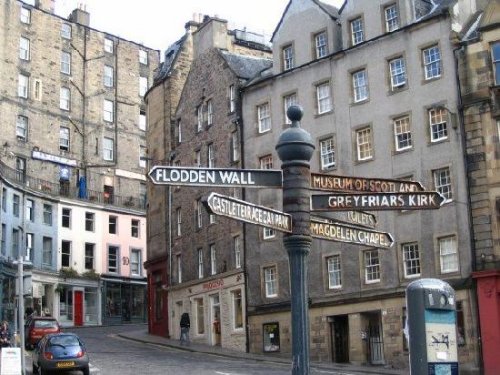
Old Town Edinburgh
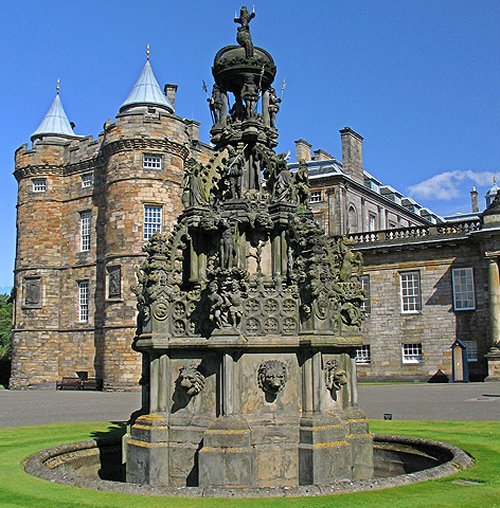
Palace of Holyroodhouse
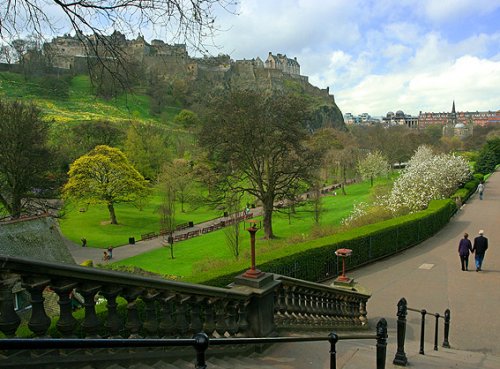
Edinburgh Castle atop the hill and the Princes Street
Gardens
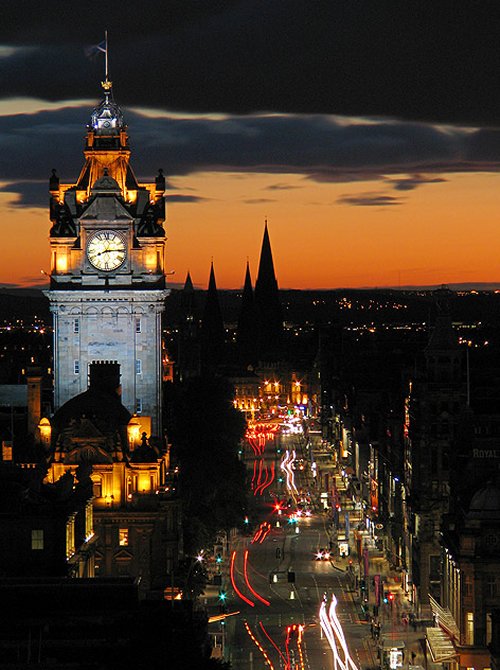
Calton Hill |
|
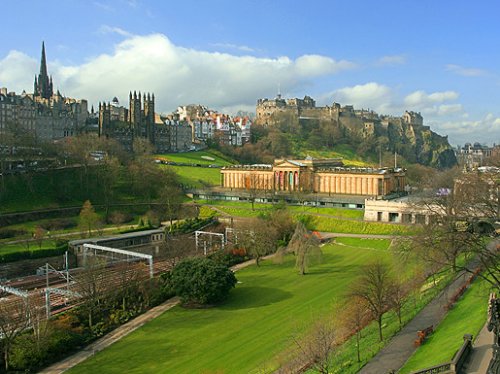
Edinburgh Castle |
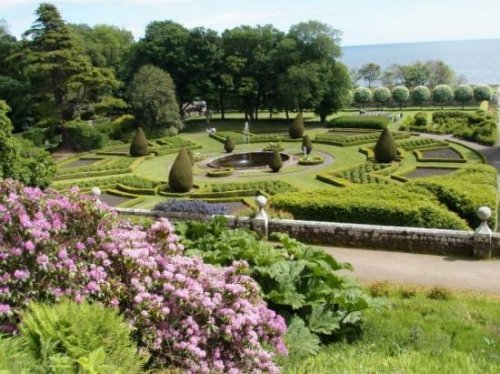
Gardens at Dunrobin Castle |
|
|
Loch Ness,
Scotland |
|
|
|
Loch Ness,
Scotland |
Day
Eight |
Loch Ness is
Scotland's second
largest lake (Loch Lomond is the
largest), but it is definitely
Scotland's most famous
lake thanks to the
greatest myth in modern times.
Everyone has heard of the legend of the Loch Ness Monster,
often called Nessie or Niseag in
Gaelic. Rumors of a mysterious creature
living in the lake have been around for
centuries (with the earliest account
being attributed to a record of the life
of St. Columba in the 6th century).
It was not until the mid-1900s that the
legend of a plesiosaur-like animal
living in the lake spread outside of
Scotland. Since then, there have been
about 10,000 reported Nessie sightings.
Many other lakes have also claimed to
have their own monsters, including one
in Japan and another in Turkey.
Regardless of whether or not there is a
monster living in Loch Ness, the legend
has become a part of the local culture.
In 2003, a group called the South Loch
Ness Heritage Group was founded to
promote and preserve local culture
through exhibitions, lectures and other
activities.
Even if you do not see the Loch Ness
Monster on your visit, the beauty of the
lake and the Scottish Highlands should
make up for the disappointment. This
region of great natural beauty is home
to many museums, moors and picturesque
villages.
Loch Ness is located on the Great Glen,
which bisects the Highlands of Scotland.
It resembles a rift valley but is in
fact a lateral fault. The rocks of
Scotland, Scandinavia and North America
were once one continent, separated by an
ocean from the rocks of England and the
rest of northern Europe. Around 420
million years ago in a continental
collision called the Caledonian Orogen
the rocks of Scotland collided with the
rocks of England. Around 40 million
years later, the Highlands north of what
is now the Great Glen slipped sideways
relative to the south side; geologist W
Q Kennedy reported matching granites at
Strontian with those at Foyers,
65 miles to the east.
The great Glen stretches between
Inverness in the East and Fort William
in the West. There are several lochs in
the Great but Loch Ness is the longest,
and the deepest, with a depth variously
said to be between 700 and 900 feet (the
North Sea's deepest point is about 150
feet). The Bathymetrical
Survey of the Fresh-Water Lochs of
Scotland, 1897-1909 reports that
in 1901 Murray and Pullar using a wire
sounder found the greatest depth of the
Loch to be 754 feet. Deeper sonar
soundings have not been independently
verified. The average temperature of the
Loch varies by only one degree
Fahrenheit during the year, as the
volume of water is so large and there
are few shallows. Some areas of surface
water may heat up in the summer by
several degrees, for example in the
shallows of Urquhart Bay, where the
Coiltie and Enrick rivers debouch into
the Loch. The bottom of the loch is
deeply silted.
The current history of the loch goes
back to the end of the last Ice Age
roughly 12,000 years ago when the
glaciers melted. During the Iron Age,
primitive tribes built a crannog near
Fort Augustus, which is now called
Cherry Island. Driving oak trunks into
the relatively shallow waters on the
edge of the Loch, which was then
infilled with earth, made it. The
crannog was a safe place to retreat to
in winter when wolves and bears roamed
the area. To this date, it is the only
island in Loch Ness. When Thomas Telford
built the Caledonian Canal to link the
North Sea and the western coast of
Scotland, in order to minimize the
considerable amount of digging involved
a weir was constructed at Dochfour which
had the effect of raising the level of
Loch Ness by about 9 feet, which means
that the crannog is rather smaller now
than when it was first constructed.
Legends of a monster in Loch Ness have
existed for over a thousand years. In
the sixth century a biography called
The Life of St. Columba reports that
the saint saved a man from being
attacked by the Loch Ness monster simply
by making the sign of the cross and
commanding the beast to retreat. Other
sightings before 1933 indicate some sort
of large fish. Mrs. Aldie Mackay's
sighting of 1933, however, saw the name
"Loch Ness Monster" used for the first
time and the scene was set for Nessie to
become the most enduring mystery of
recent years.
In July 1933 Mr. George Spicer and his
wife had a land sighting. They saw 'a
most extraordinary form of animal' cross
the road in front of their car. They
described the creature as having a large
body (about 4 feet high and 25 feet
long), and long, narrow neck, slightly
thicker than an elephant's trunk and as
long as the width of the road (about
10-12 feet wide); the neck had a number
of undulations in it. They saw no limbs
because of a dip in the road obscuring
the animal's lower portion. It lurched
across the road towards the loch 20
yards away, leaving only a trail of
broken undergrowth in its wake.
Over the subsequent decades, there were
more unexplained sightings, mainly of a
single hump, sometimes described as like
an upturned boat. There were also many
hoaxes. The issue took on international
importance and several groups of
scientists have now undertaken research
expeditions attempting to prove or
disprove the existence of such a
monster. In all, thousands of people
have claimed to see Nessie, though only
a few fuzzy and inconclusive pictures
have ever been captured of the putative
animal.
|
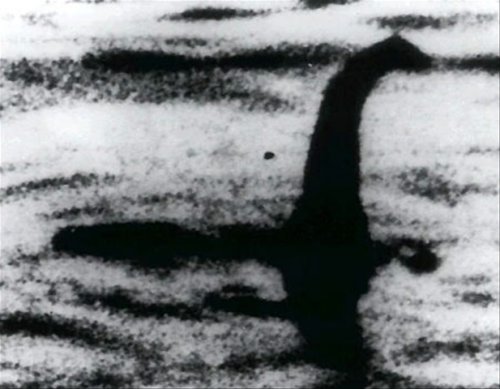
The famous picture that started all the fuss
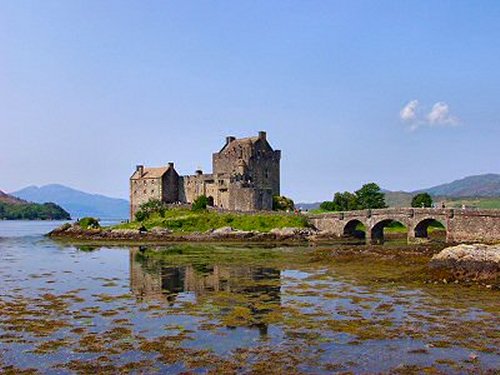
Urquhart Castle
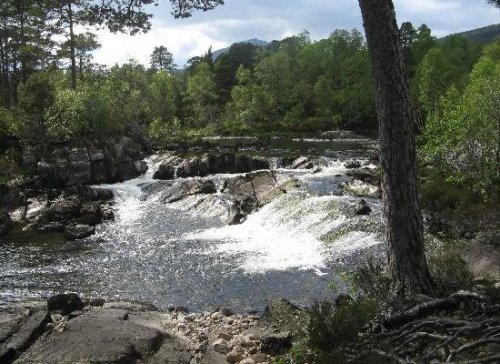
|
|
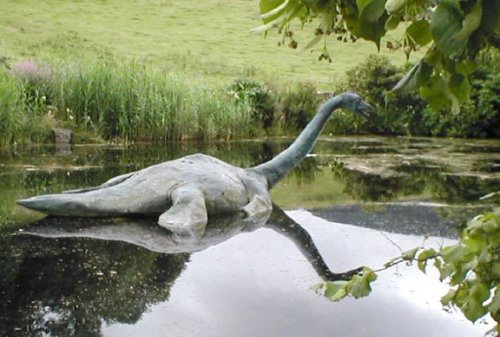 |
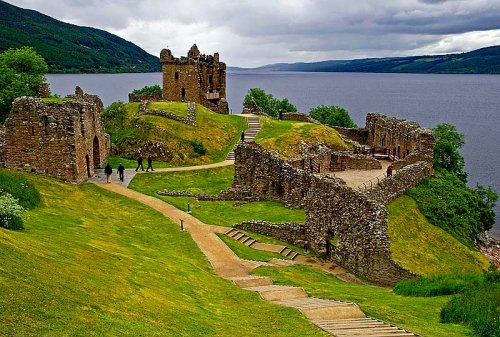 |
About the
Oslo 2010 Trip
|
|
|
The Oslo Trip will be our 17th SSQQ Cruise Trip.
As always, you have the best of both worlds.
You can be alone with your sweetheart sharing a
croissant at a local cafe in Paris or you can hang with the group whenever you
wish. Wherever you go, you will always have
friends. We watch out for each other. At
dinner time when you wish to share tales of your
adventures, you won't be talking to strangers, you
will be talking with friends from home.
We chose this week for two reasons. We were
able to get a good rate for this great sailing time
(cooler temps and less children). Also, due
to the studio transition, we thought it would be the
perfect time for the next adventure. What better
time for us to go exploring?
Our trip will be aboard Royal Caribbean’s
Vision of the Seas.
This ship is part of Royal Caribbean's Vision
Class,
a sister ship to the Rhapsody of
the Seas, our long lost love. It is
a smaller ship than the Voyager or the Navigator,
but still has beautiful wooden dance floors in a spacious attractive non-smoking
lounge.
Thousands of windows on this ship
will showcase our views! The ship has
full fitness center and spa, a
sports deck with a rock-climbing wall
and
basketball court
|
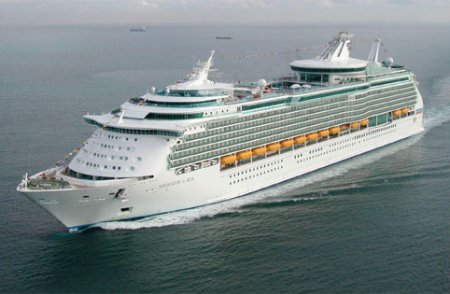
RCCL Vision of
the Seas
|
If you
wish to go, here is what you
need to do:
Fill out the registration form and provide a credit card number for your
$450 deposit.
This is a slightly larger deposit because it is a 9
day cruise. All passengers must have a
Northern Europe Cruise 2010 registration form on file.
There will be new rules in effect for this cruise.
The first deposit
of $450 per person is
due by
November 6th, 2009.
Final payment is due on February 22nd, 2010.
Please Note:
If you would like a specific cabin type/location not
offered, please call and I will get that rate
quoted.
Contact Marla Archer at 713 862-4428 or e-mail
marla@ssqq.com
with any
further questions.
REGISTRATION FORM
|
|
|
|
|
|